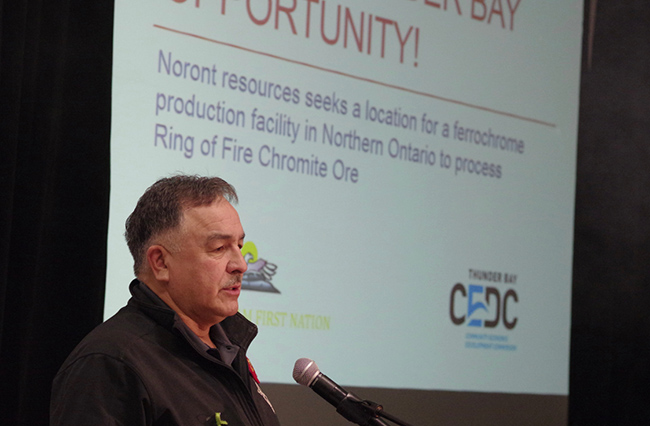Public information sessions for possible Noront facility in Thunder Bay

By Rick Garrick
Fort William and Thunder Bay Community Economic Development Commission (CEDC) representatives recently held two public information sessions for the Noront Resource ferrochrome production facility request for proposal.
“There is still a lot of work whether it ends up in Thunder Bay or not,” says Fort William Chief Peter Collins, noting that Fort William, Thunder Bay and CEDC are partners in the request for proposal. “We’re in a competing journey along with the other cities like Sault Ste. Marie, Sudbury and Timmins. We’re competing for the possibility of building that ferrochrome processing plant here in Thunder Bay, in partnership with Fort William and CEDC.”
Collins says there were some concerns about environmental impacts from the proposed ferrochrome production facility that were brought forward during the public information sessions. The first public information session was held on Jan. 15 at the Fort William First Nation Community Centre and the second session was held on Jan. 17 at the Valhalla Inn in Thunder Bay.
“For Fort William and our perspective, everything has to be done in fashion that does not have an impact on the environment,” Collins says. “Those are the concerns that we’ve been having for quite some time now. We’re starting to feel comfortable on a lot of the technology and a lot of the work that has been done on making sure the environment is safe and sound.”
Edmond Collins, Fort William’s manager of economic development, says the first session in Fort William went “very well,” with community members from Fort William and Thunder Bay in attendance.
“They asked a couple of hard-hitting questions, especially about the environment, which was really good to see because that’s what we need to know,” Edmond says. “We need to know those hard facts about the project.”
Both Collins appreciated the opportunity to hear from an expert from Finland, Timo Haimi, senior process metallurgist with Outotec, about the Finnish experiences with a ferrochrome production facility during the two sessions.
“Timo from Finland showed us exactly what a plant looks like right in close to the city settings and in and around water in particular,” Collins says. “If you look at where their ferrochrome processing plant is, it is directly on the shores of a fairly substantial lake.”
Haimi noted that Finland has been processing chromite since the 1960s and is now supplying their chromite processing technologies to other countries in the world.
“To make the process more environmentally friendly you need to close the furnace to make sure you don’t have any air infiltration,” Haimi says, noting that chromium will oxidize into more dangerous forms if air leaks into the furnace, which operates at about 800-1,000 degrees Celsius. “This is the key to make the chromium process to be environmentally friendly.”
The three partners estimate that the proposed chromite production facility will employ more than 350 people and create industrial service and supply spinoff opportunities.
“We believe that the material mined in northwestern Ontario should be processed in northwestern Ontario to its maximum value added state,” says Doug Murray, CEO for CEDC. “We have a good support system for start-up companies in our communities, and involving local entrepreneurs and students from the college and university to this industry will lead to new companies and employment for our residents.”
Ferrochrome is required in the production of stainless steel, which is growing at an annual rate of about about five per cent. North America does not currently produce ferrochrome.


